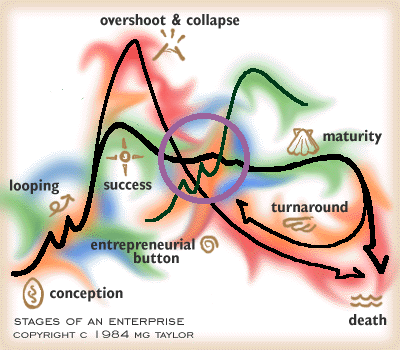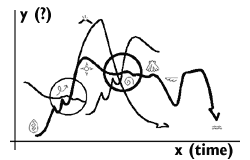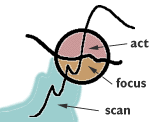
|
|
Like the other models of the MG Taylor Modeling Language, the Stages of an Enterprise Model is protected by copyright. You can use it only by meeting these four conditions. Here's the model
Green stands for times of stability and success. Orange stands for warning. Red indicates behavior far from homeostasis, which if allowed to continue, will lead to the death of the system. Blue represents times of flux around the entrepreneurial button. Now let's look at the stages:
The Mystery AxisThis is a familiar model to most people in the MG Taylor network. So here's a tricky question for all of you experts. Let's assume that the model is plotted against an "x" and "y" axis. The x axis represents time. The diagram below shows the model plotted in this fashion. [Note that the turnaround stage has been changed to a deep dip in the Maturity curve in order to fix the somewhat disconcerting idea that the turnaround takes you back in time.] The question is, what label might you place on the y axis?
Any guesses? Productivity? Not really. Start-up teams can be very productive but they're depicted way down on the curve. How about homeostasis? That would be closer and would work if we assumed the homeostasis of the enterprise to be the x-axis, and moved it up level with maturity. Anything above the axis would be like a fever, and anything below it like hypothermia. But this still doesn't feel quite right. What property of Enterprises begins near zero, rises to a peak in success, falls of in maturity, dips in the turnaround, and then dives to the x-axis in death? I'll leave you hanging and return to the problem later. Better yet, e-mail me with your ideas. Maybe even do a Personal Journal page on the question!
Pushing the Button: Innovation vs ImprovementBelow is another modification of the model. In this case, instead of showing a peak at the Success stage which falls off to a lower Maturity plateau, the curve continues upwards at a gentle slope (the blue line). This represents continuous improvement in the enterprise. The y-axis in this case can be roughly termed "quality of product/ energy expended"--a sort of hybrid of quality and efficiency.
To make a big leap of innovation, however, the Entrepreneurial Button must be pushed. This means one of several things:
In either case, the Entrepreneurial Button is not simply a zone where transformation just happens. The button doesn't occur at some predetermined location in the model, although there are more or less favorable times--one of the most favorable being the period of maturity, just after success.
Pushing the button is a conscious decision. Much of the conceptual work will already have been done. The new idea will have passed through some looping already before the decision is made to launch it. The people making the decision are not always the executive management. An idea can be so powerful that it may "seek out" other people to launch it if no one in the parent organization is interested. The classic, if overused, case is the visit by Steve Jobs to Xerox PARC where he saw the system that would later be born as the Macintosh. In this case, Xerox management did not push the button, but Jobs did. Pushing the button may be a trigger point in moving the new idea/organization from Scan into Focus [see the Scan Focus Act model].
The Entrepreneurial Button can be thought of as a membrane of sorts. It's both an incubator and crucible within which the new idea will be nourished and also besieged. It's most vulnerable at this point. Before entering the button, the idea is just an idea, but pushing the button sanctions it, making it a real opportunity or threat to some. Once it's out of the top side of the button's membrane, the idea has become a viable enterprise, capable of fending for itself. Only while it's in the membrane does it need special support and defense. Several other articles on this website address this model and its variations directly. For a metaphorical comparison of the model with quantum mechanics, click here. To read about the act of consciously invoking the overshoot and collapse path in the quest for increasing returns, click here. Copyright © 1996, MG Taylor Corporation.
All rights reserved 19960930152113.web.bsc |
|
Copyright,
|
iteration
3.5
|
























